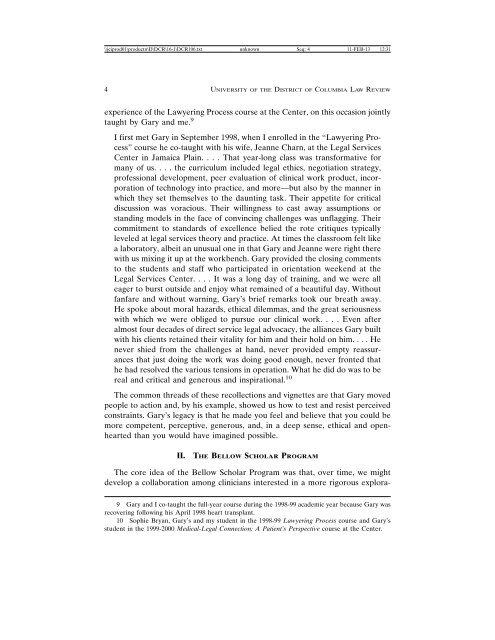volume 16, number 1 - UDC Law Review
volume 16, number 1 - UDC Law Review
volume 16, number 1 - UDC Law Review
- No tags were found...
You also want an ePaper? Increase the reach of your titles
YUMPU automatically turns print PDFs into web optimized ePapers that Google loves.
\\jciprod01\productn\D\DCR\<strong>16</strong>-1\DCR106.txt unknown Seq: 4 11-FEB-13 12:314 UNIVERSITY OF THE DISTRICT OF COLUMBIA LAW REVIEWexperience of the <strong>Law</strong>yering Process course at the Center, on this occasion jointlytaught by Gary and me. 9I first met Gary in September 1998, when I enrolled in the “<strong>Law</strong>yering Process”course he co-taught with his wife, Jeanne Charn, at the Legal ServicesCenter in Jamaica Plain. . . . That year-long class was transformative formany of us. . . . the curriculum included legal ethics, negotiation strategy,professional development, peer evaluation of clinical work product, incorporationof technology into practice, and more—but also by the manner inwhich they set themselves to the daunting task. Their appetite for criticaldiscussion was voracious. Their willingness to cast away assumptions orstanding models in the face of convincing challenges was unflagging. Theircommitment to standards of excellence belied the rote critiques typicallyleveled at legal services theory and practice. At times the classroom felt likea laboratory, albeit an unusual one in that Gary and Jeanne were right therewith us mixing it up at the workbench. Gary provided the closing commentsto the students and staff who participated in orientation weekend at theLegal Services Center. . . . It was a long day of training, and we were alleager to burst outside and enjoy what remained of a beautiful day. Withoutfanfare and without warning, Gary’s brief remarks took our breath away.He spoke about moral hazards, ethical dilemmas, and the great seriousnesswith which we were obliged to pursue our clinical work. . . . Even afteralmost four decades of direct service legal advocacy, the alliances Gary builtwith his clients retained their vitality for him and their hold on him. . . . Henever shied from the challenges at hand, never provided empty reassurancesthat just doing the work was doing good enough, never fronted thathe had resolved the various tensions in operation. What he did do was to bereal and critical and generous and inspirational. 10The common threads of these recollections and vignettes are that Gary movedpeople to action and, by his example, showed us how to test and resist perceivedconstraints. Gary’s legacy is that he made you feel and believe that you could bemore competent, perceptive, generous, and, in a deep sense, ethical and openheartedthan you would have imagined possible.II.THE BELLOW SCHOLAR PROGRAMThe core idea of the Bellow Scholar Program was that, over time, we mightdevelop a collaboration among clinicians interested in a more rigorous explora-9 Gary and I co-taught the full-year course during the 1998-99 academic year because Gary wasrecovering following his April 1998 heart transplant.10 Sophie Bryan, Gary’s and my student in the 1998-99 <strong>Law</strong>yering Process course and Gary’sstudent in the 1999-2000 Medical-Legal Connection: A Patient’s Perspective course at the Center.














